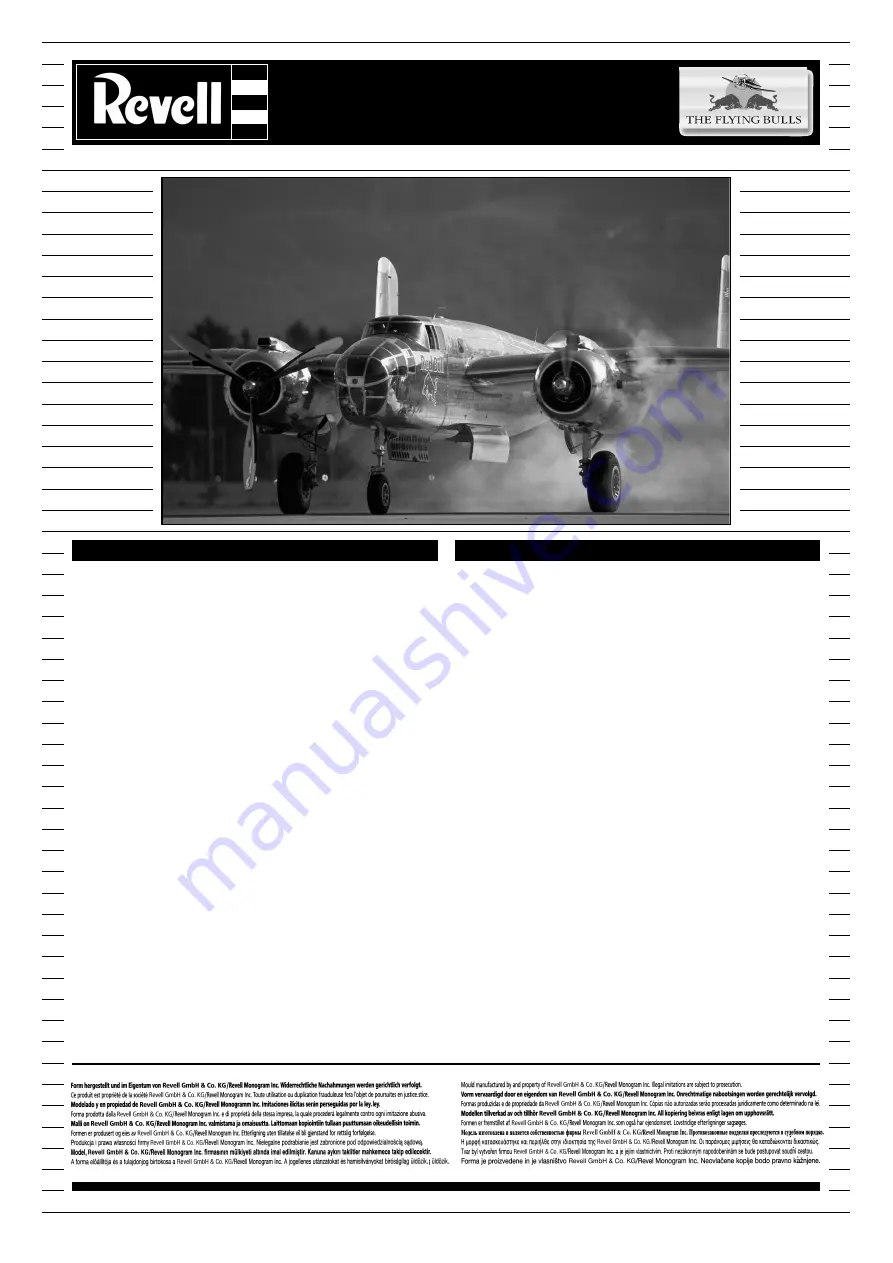
B-25J Mitchell
A
05753-0389
2003 BY REVELL GmbH & Co. KG
PRINTED IN GERMANY
B-25J Mitchell
B-25J Mitchell
Die B-25 Mitchell machte ihren Erstflug im Jahr 1940. Schon im
Dezember 1941, als die Japaner den US-Flottenstützpunkt Pearl
Harbour angriffen, waren die ersten B-25A bei der Air Force im
Kampfeinsatz. Der B-25A folgte der Typ B-25B mit einem
Geschützturm mit zwei MGs am hinteren Rumpf. Von den insge-
samt 870 Stück wurden 72 in die Sowjetunion exportiert.
Die neueren C- und D-Muster kamen unter anderem in die Nieder-
lande, nach Brasilien und Kanada. Die 400 Stück B-25 vom Typ G
verfügten 1943 über eine 75-mm-Kanone in einem festen Rumpf-
bug. Das Folgemodell – B-25H – war eines der am schwersten be-
waffneten Flugzeuge der damaligen Zeit: Mit 14 weiteren Bord-
MGs und einer Vorrichtung zum Mitführen eines Torpedos oder
von 1450-kg-Bomben.
Die Hauptversion der Mitchell war mit 4318 Exemplaren die B-25J.
Im Unterschied zur B-25H hatte sie einen verglasten Rumpfbug,
eine geänderte Bewaffnung und eine sechsköpfige Besatzung. In-
sgesamt war die B-25 der meistgebaute mittelschwere Bomber
des Zweiten Weltkriegs.
Die B-25J Mitchell der Flying Bulls
Die in Kansas City gebaute B-25J der historischen Flugzeugsamm-
lung Flying Bulls in Salzburg war nie im Kriegseinsatz sondern
wurde zunächst als elektronische Testplattform verwendet. Die
geplante Umrüstung zu einem Löschflugzeug wurde nie realisiert.
Stattdessen kam sie Anfang der Achtzigerjahre zu einem
Fliegerclub wiederum nach Kansas City. Dort wurde sie 1995 von
den Piloten der Flying Bulls entdeckt, gekauft und von Experten in
20.000 Arbeitsstunden restauriert und auf komfortabel umge-
baut. 1997 wagte sie den Flug über den Atlantik, seit 2001 hat sie
ihre Homebase am Flughafen Salzburg. Von dort aus startet sie im-
mer wieder zu den großen Airshows in ganz Europa.
The B-25 Mitchell made its maiden flight in 1940. Already in De-
cember 1941, as the Japanese attacked the U.S. naval base at Pearl
Harbour, the first B-25A aircraft were being used in combat by the
Air Force. The B-25B model with a gun emplacement followed the
B-25A with two machine guns on the rear part of the fuselage. Of
the 870 total aicraft, 72 were exported into the Soviet Union.
The newer C and D models went to the Netherlands, Brazil,
Canada and a few other countries. In 1943, the 400 B-25 Model G
aircraft was equipped with a 75-mm gun in the solid nose of the
fuselage.
Its successor, the B-25H, was one of the most heavily armed air-
craft of those days. Equipped with 14 more machine guns and ca-
pable of carrying a torpedo or 1450 kg bombs, the main version
of the Mitchell model was the B-25J with 4318 machines built.
In contrast to the B-25H, it had a glazed fuselage nose, modified
weaponry and a six-member crew. In total, the B-25 was the
most-manufactured medium-sized bomber of WW II.
The B-25J Mitchell of the Flying Bulls
The B-25J, built in Kansas City, was part of the historic airplane col-
lection called the Flying Bulls in Salzburg, Austria. It was never used
in combat, but rather as an electronic testing platform. The
planned changeover to a firefighting plane was never realized. In-
stead, it once again returned to Kansas City at the beginning of
the 80s, coming into the possession of a flying club. There, it was
discovered in 1995 by pilots of the Flying Bulls, purchased, restored
by experts in 20,000 man-hours and equipped for comfort. In
1997, it dared to make a trans-Atlantic flight. Since 2001, its home
base has been at Salzburg Airport. From there, it departs again
and again for the great air shows throughout Europe.
Содержание THE FLYING BULLS B-25J Mitchell
Страница 10: ...05753 PAGE 10 36...
Страница 11: ...05753 PAGE 11 37...





























